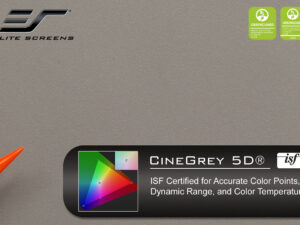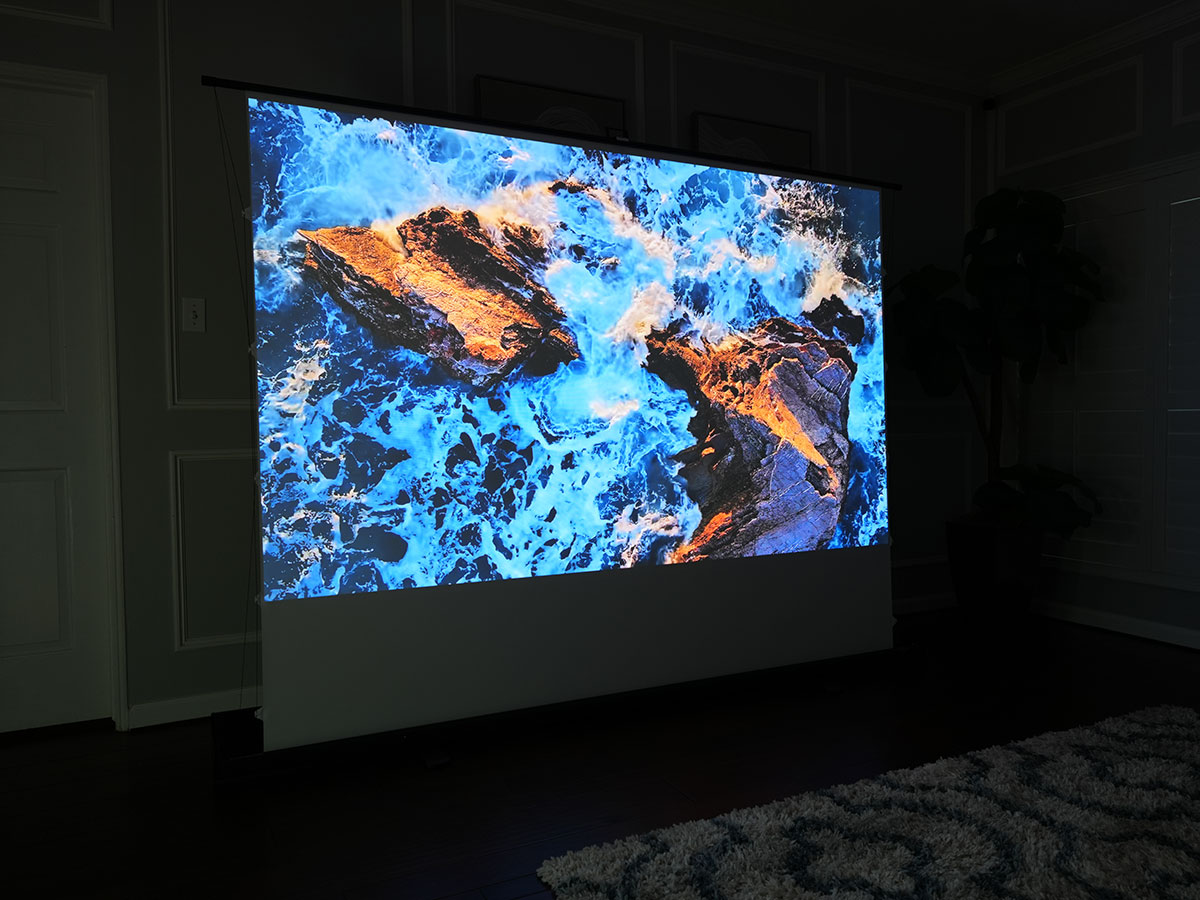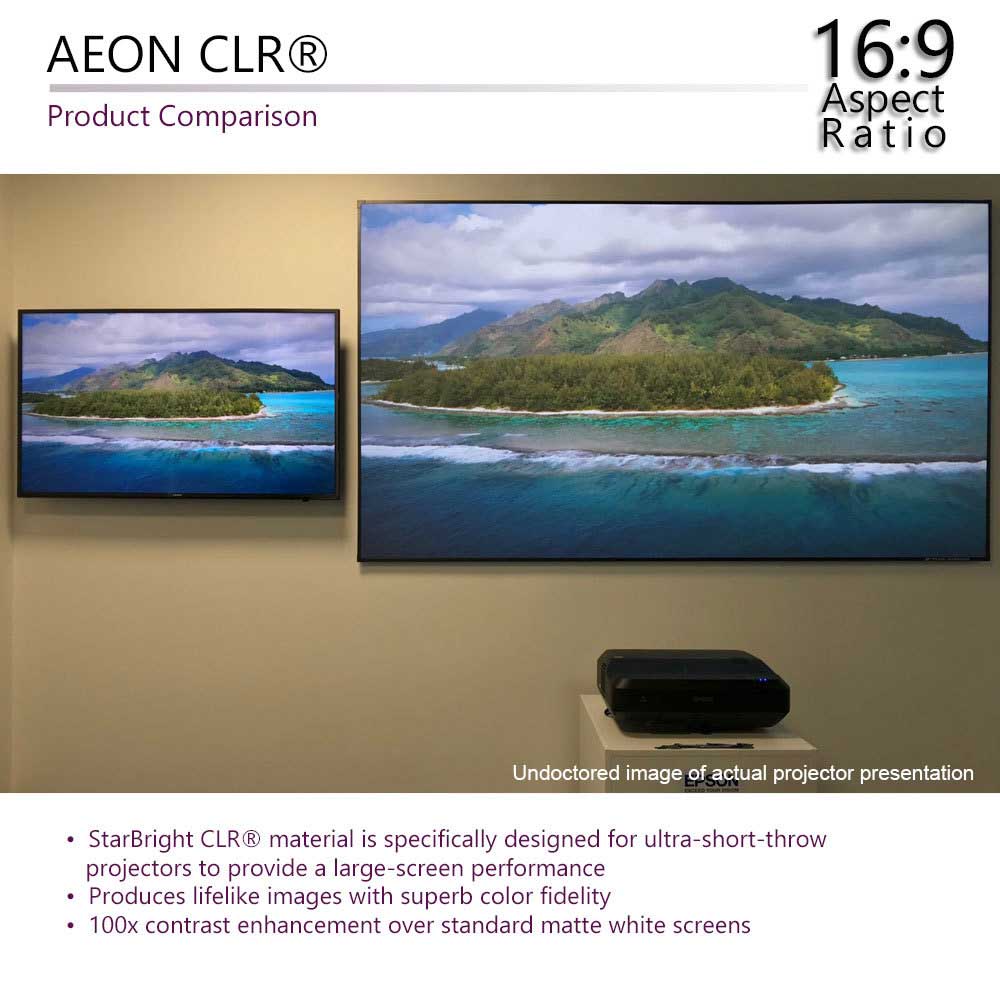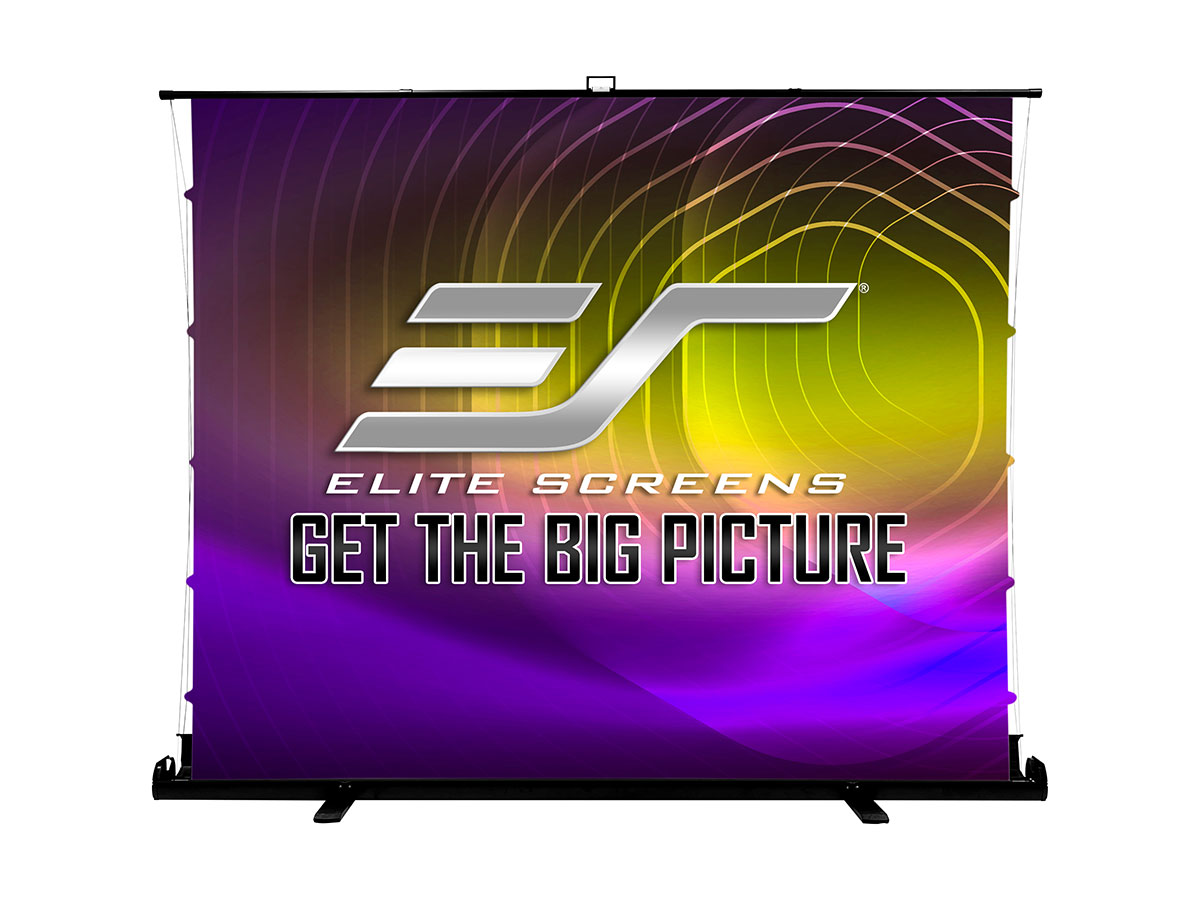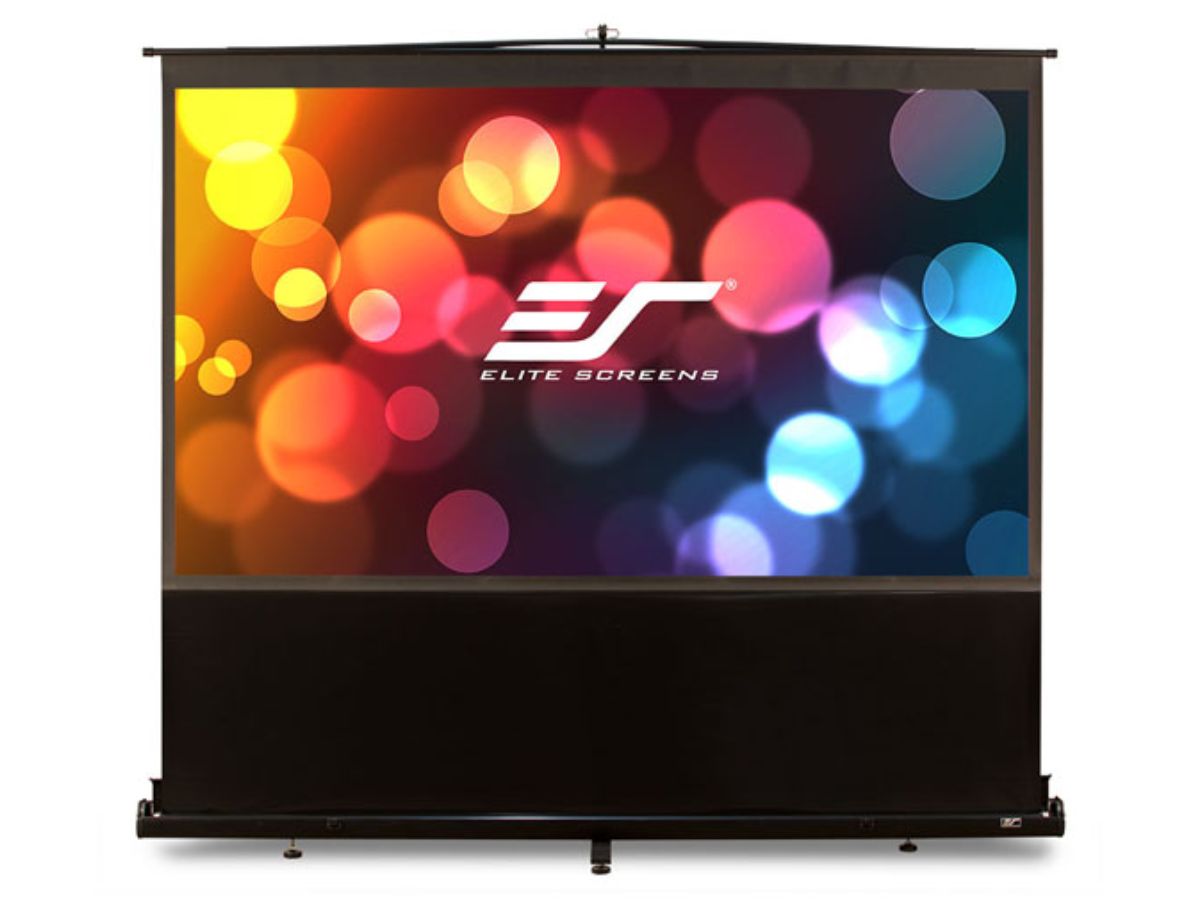Product Review: ezFrame Projection Screen With CineGrey 5D®
- Product: ezFrame CineGrey 5D® Series (R84DHD5) 84” – 16:9 aspect ratio
- Projector: Epson 3-LCD
- Reviewer: Doug Blackburn Widescreen Review Magazine
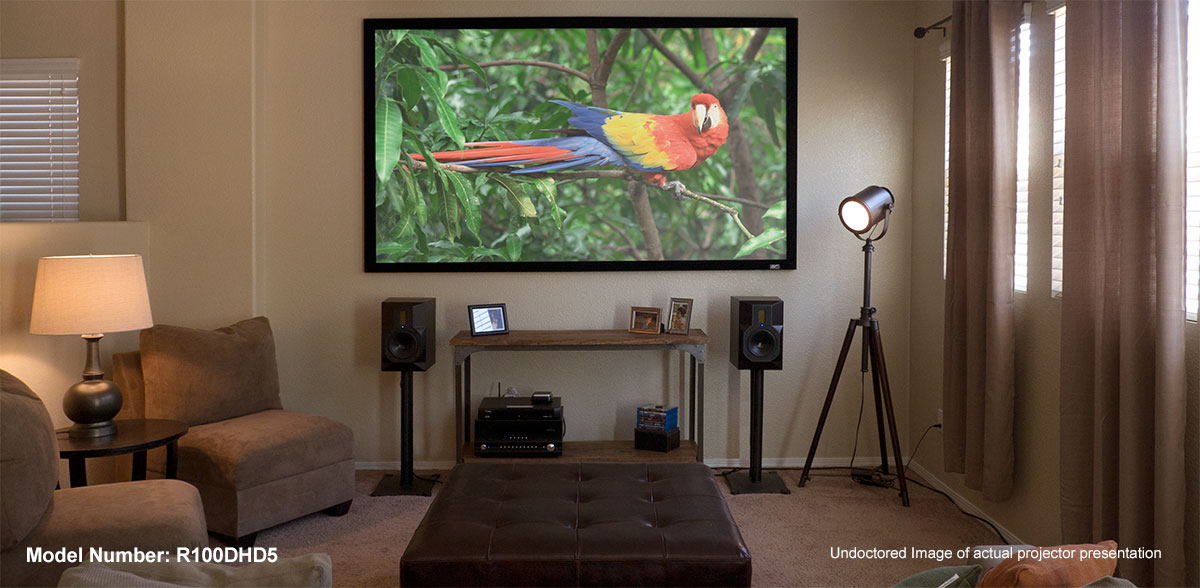
Southern California-based Elite Screens has offices in Europe, Japan, Australia, Taiwan, and India. They don’t make other products, but the array of projection-related products and accessories is impressive. Screens are available with fixed frames, motorized frames, portable screens, outdoor screens, ambient light rejecting screens, dry eraser whiteboard screens, screen paint to paint a screen on a wall, and screen materials for rear projection.
One of the most surprising features of the CineGrey 5D screen is the cost. I evaluated the 84-inch diagonal model, the smallest screen size offered. I find it rather amazing that Elite Screens can make money selling this size screen for $544 including shipping. Nothing about the appearance/finish, materials, or manufacturing quality appears to be “economical.” The CineGrey 5D screen could just as easily sell for $1,000 or $2,000 or more since there’s nothing about the appearance to indicate anything other than top notch materials and parts. The reference screen I use is roughly the same size, but it sells in the neighborhood of $3,500. Of course, the CineGrey 5D® material’s “job” isn’t to be a “reference” projection screen. Instead the CineGrey 5D® material is formulated for installations that will benefit from a 50 percent gain in reflected light compared to a “standard” 1.0 gain projection screen. And the CineGrey 5D® coating rejects off-axis light, aka ambient light rejecting.
The tensioning system produces a perfectly flat projection screen, even if five or six random tensioning springs are not hooked into their appropriate eyelets in the perimeter of the screen material. The entire screen assembly for the 84-inch diagonal size is nice and light and easy to handle. Wall-mount brackets came with the projection screen. Elite is not currently offering other aspect ratios of the CineGrey 5D® material, 1.78:1 is the only aspect currently offered.
Setup was easy. The two longest frame sides were cut in half to make the box smaller than it would have to be otherwise. Joining the two halves is a simple matter of using two tap-strips and four screws. Frame corners are held together with two 90-degree corner brackets in each corner with four screws holding each bracket in their corner. The ezFrame rails are 2.5 inches wide and are covered with very dark black velvet. A center/vertical “spreader bar” fitted to the back of the assembled frame keeps the long dimension of the frame “stiff.”
Immediately after setup and for several more days, the screen material gave off an almost pleasant faint odor of plastic. It faded each day until it disappeared.
The job of an ambient light rejecting projection screen is to eliminate or reduce loss of contrast on-screen from having uncontrolled light in the room with the projector. However, there are limits. Light that originates behind the projector can’t be rejected because doing so would also reject the projected image… not a good thing. So installations where an ambient light rejecting screen can really help are the ones that have the light coming in from the side of the room. The more directly to the side of the screen the ambient light source is, the more of it will be removed by the projection screen.
Screens with gain direct a larger portion of the light hitting the screen back towards the viewers. A reference screen reflects light equally in all directions. A projection screen with the highest possible gain looks good when you sit directly in front of it, but screen brightness will fall off dramatically as you move off-center. This is possible by putting particles with the proper reflective properties in the screen coating. I’ve seen so many screens with gain that have had “hot spotting” that I was beginning to think you couldn’t get a screen with gain without hot spotting. Hot spotting, most often, has the appearance of a cloud of mosquitoes flying closely together. This effect often follows your field of vision. If you look at the center of the image, you see the “noisy” area right in the center portion of your field of vision. If your eyes move to see action on the left side of the screen, the “hot spot” will move to the left side as your eyes move to follow the action. A good projection screen with gain avoids the “hot spotting” as much as possible, but it can be impossible to remove 100 percent of the hot spotting noise you get when a screen has gain. The CineGrey 5D has hot spotting, but it is very minor. Many owners will never even see it. I reviewed a 1.4-gain screen over five years ago, and it had maddeningly obvious hot spotting that was nearly impossible to forget about when watching a movie. In comparison, the CineGrey 5D screen at first appeared to have no hot spotting at all. As I accumulated more viewing time, I began to notice that there is some noise in the reflected images, but it’s very low in level over the entire screen rather than being very strong in the center of your field of vision, tapering off as you move away from the center of your vision. For all practical purposes, Elite has made hot spotting darn near a non-issue for the CineGrey 5D® screen. The closest performance I’ve seen to this comes from Stewart Filmscreen’s much-more-expensive StudioTek 130 (now in Gen 3), a 1.3 gain screen I’ve consistently been impressed with in regards to not having visible hot spotting. But the StudioTek 130 isn’t an ALR (ambient light rejecting) projection screen.
The gray color of the CineGrey 5D® screen can help to improve the perceived black level of images by reflecting less light when image information approaches the shadows and darkness. The CineGrey 5D® screen did a pretty good job of that, causing blacks and shadows to look darker than I’m used to seeing them when using projectors with three transmissive LCD imagers or when using a DLP projector with a Dark Chip 3 (that doesn’t produce a very satisfying black). I just happened to be using an Epson projector with three transmissive LCD imagers while I was evaluating the CineGrey 5D® screen. While light-, medium-, or dark-gray screens can make black levels appear improved, that can sometimes come with the loss of bright whites, but the CineGrey 5D® screen didn’t cause me to think that white and other bright colors had gotten any darker. In fact, with the gain the screen has, I felt like I was seeing brighter whites and darker blacks—something no home theatre projection enthusiast would refuse. I admit to liking the CineGrey 5D® screen a lot.
As I accumulated hours of use, I found that it was easier and easier to forget about looking for any hot spotting or other obvious “additions” or “subtractions” to images and just enjoy how nice the images from the Epson 3-LCD projector looked. After calibrating with the CineGrey 5D® projection screen, images improved even more, and the screen became less and less of a focus of my viewing.
With the projector calibrated for the StudioTek 100 reference screen, images didn’t look as good as they could if everything was just right for the Elite screen. So I recalibrated with the CineGrey 5D® screen in the system to get the best possible gray scale, gamma, and color within the limits of the projector’s adjustments. Images were satisfying with no distractions. Colors were vibrant when appropriate and were quite restrained when color saturation was very low, as at the beginning of Ready Player One, where most color is very de-saturated. Image detail held up very well, and those able to get out of analytical mode and into entertainment mode will enjoy the CineGrey 5D® screen very much.
Elite says the CineGrey 5D® material preserves polarization of the reflected light, making the CineGrey 5D® suitable for use with passive 3D setups, where the glasses are passive, and either two projectors with different polarizers or one projector with polarizing filters that flip-flop in proper sync with 3D movies. Since I don’t have a passive 3D setup here, I wasn’t able to test that properly. But I did view 3D movies with active shutter 3D glasses, and those produced the same results I get with the reference projection screen.
What will you do with your Elite CineGrey 5D® projection screen? Will you finally be able to get that larger projection screen you’ve been wanting for years? Finally get into projection because you can get a first-rate projection screen for less than the cost of a mid-range 65-inch flat screen TV? You may even find that the projector at the top of your budget that you thought needed to have blacker blacks, and perhaps have a brighter 100 percent white, can perform well enough with a CineGrey 5D® projection screen that your dream of a home theatre setup might actually come true, especially with the projection screen being so reasonably priced. As projection screens go, Elite’s CineGrey 5D® is not only a bargain, but it performs so well at its modest price point that your hesitation about going to a projection system will finally dissipate.
Everything I viewed looked great. The screen revealed differences in resolution between HD, UHD from a 2K Digital Intermediate, and UHD from a 4K Digital Intermediate very easily. Projectors with pixel shifting looked as good as they have looked on any other screen material. Native 4K or UHD resolution imagers show the extra detail you can see when the pixels are the proper size with very little space between them.
Conclusion
Elite Screens’ CineGrey 5D® projection screen surprised me. With 1.5 gain, ambient light rejection, and a gray color to improve the perceived blackness of blacks, and a spectacularly reasonable price, the CineGrey 5D® screen gives a needed boost many home theatres can benefit from. In a theatre built with a modest budget, the projector can easily be a fairly limiting element of the system. Changing to a CineGrey 5D® screen can actually make your theatre look better without changing anything else. But do plan on calibration after changing to one of these screens, you’ll be glad you did. The CineGrey 5D® screen is so good, I would use one if I didn’t have to have a reference screen for reviews. Elite gets “most performance for the money” with the CineGrey 5D®. I was impressed and surprised by how good images looked considering the bargain price of these screens. Highly recommended.
-Doug Blackburn, WSR Magazine
(Read this Review in WSR Magazine)


